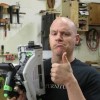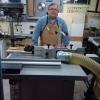This seems like such a basic question but I'm just now getting into building some custom furniture and I've got a couple tables coming up. I plan to make the tops(farm style tables) from Maple stock, and more than likely about 1 1/2" as a final/planed thickness. The tops will be basic glue ups, 5 or 6 boards, depending on width.
What prevents a glue-up, solid table top like this from getting wavy, wonky, cuppy, warpy, etc?





 Reply With Quote
Reply With Quote





